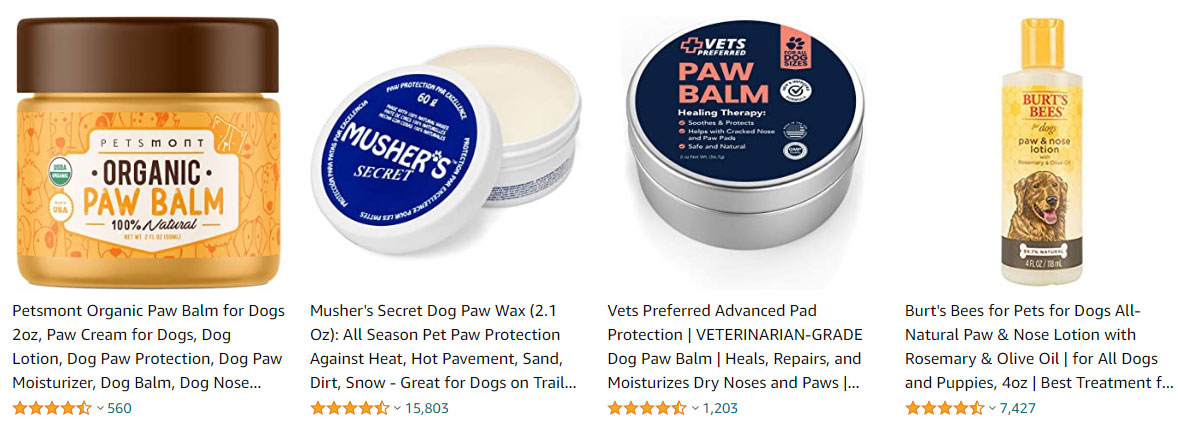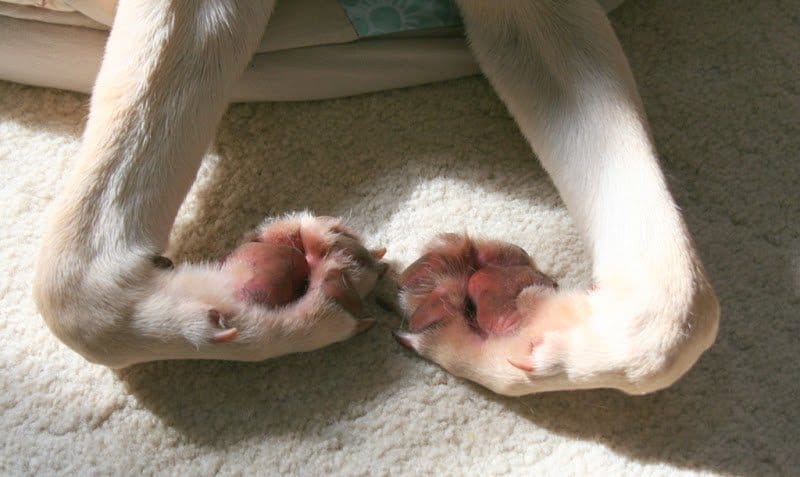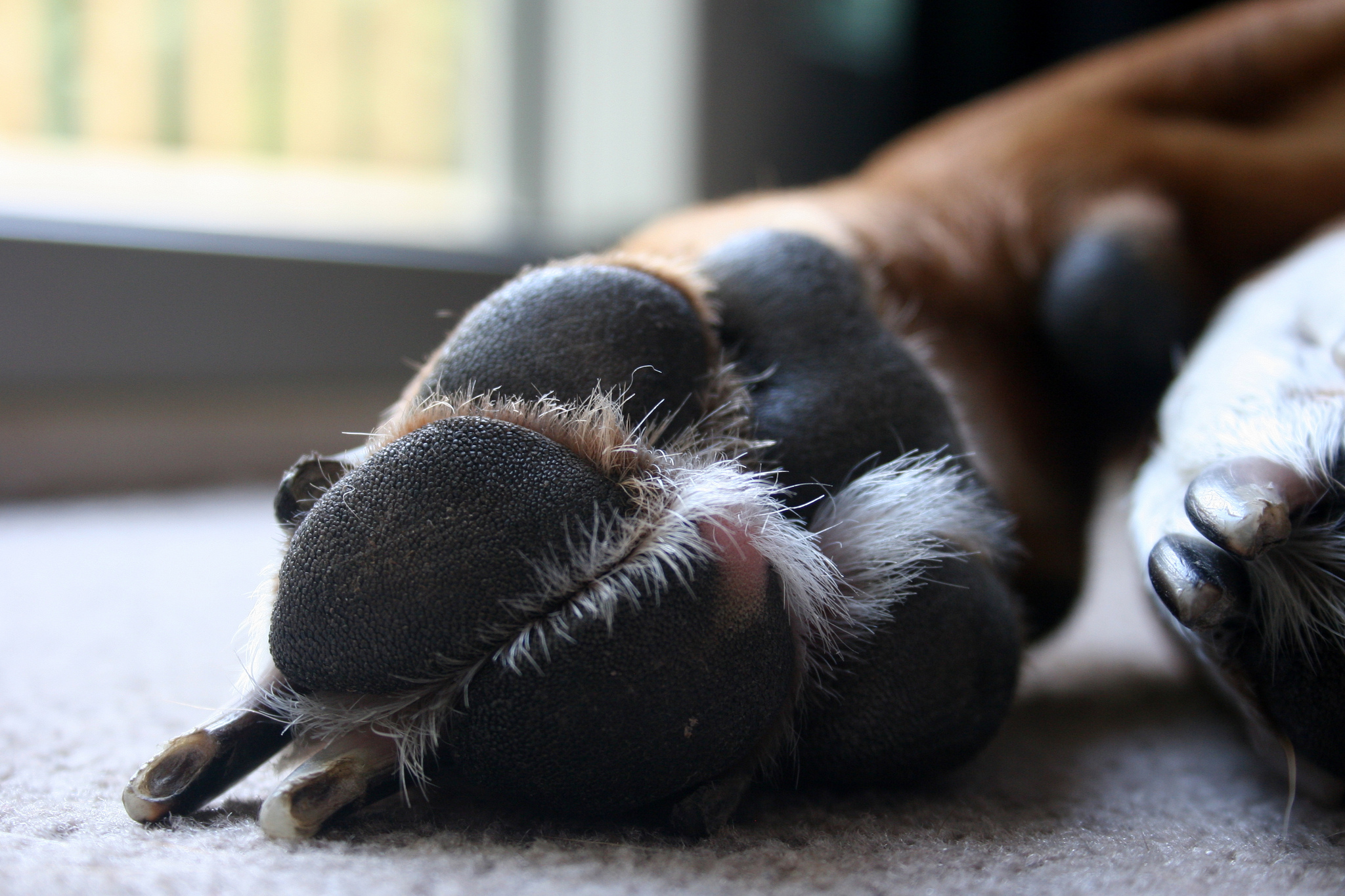Dog swollen pads
A dog can have swollen paw pads for many reasons, and finding the cause of his ailments usually requires a quick health visit to a veterinarian.
While the condition behind your dog's swollen footpads is not always serious, it is usually necessary to treat it in order to get rid of it and avoid recurrence. Today, I'm going to tell you more about the different types of pad disorders in dogs that can cause swelling, with or without other symptoms.
What are swollen pads in dogs?
Swollen footpads in dogs usually indicate pododermatitis, an inflammation of the skin on the dog's feet. The dog's footpads are elastic, fibrous and fatty tissues whose role is to support and protect the dog's toes, on which our four-legged companions move.
There are 5 digital pads, one under each of the 4 fingers and one under the dewclaw, 1 palmar pad, located at the base of the toes and 1 carpal pad. The pads are often calloused and covered with a thick skin, which allows them to cushion the dog's steps and to isolate them from the ground.
This makes them seem almost insensitive, but they are actually rich in nerve endings, as well as sweat glands that regulate body temperature through the process of sweating. Pododermatitis is a dermatological inflammation causing discomfort, pain, swelling and/or lesions on the skin of the dog's paws.
It is not a disease, but a symptom that can have various causes, and is even generally multi-factorial. The pads are not necessarily the only areas of the foot affected by pododermatitis, and it is quite rare that the inflammation is limited to these sites.
The toes, claws and dewclaws are also affected by these conditions, which are frequently associated with skin disorders that extend beyond the foot, or even over the entire body of the dog.

Causes of Swollen Pads in Dogs
There are so many possible causes of swollen paw pads in dogs that it would be impossible to list them all here - so we'll just mention the most common. The diagnosis is based on the local inflammation, but also on the general condition of the dog. Indeed, it is not rare that pododermatitis is caused by systemic affections, generating symptoms apparently unrelated to the pads of your dog (fever, digestive disorders, fatigue, depression, etc.).
Swollen Pads and Dog Trauma
If your dog's paw pads are simply swollen and the animal does not appear to be suffering from itching or skin lesions on the toes or surrounding skin areas, trauma should be considered. Your dog may have burned himself by putting his paws on your stove door, stepped on a thorn or sharp object, or swatted a wasp or other venomous insect - intentionally or not. A small wound may have developed into an abscess, in which case the swelling may be significant and the pad particularly sensitive.
Swollen pads and dog's uneasiness
A dog that is confronted with an environment and lifestyle that are not suitable for him, or adopted by an owner with brutal or awkward training methods, can develop deep-seated anxieties that lead to destructive behavior. Compulsive licking is one of the many consequences of stress on a dog's health, and a dog who licks his paws incessantly can irritate his paw pads and even cause serious lesions. It is important to note that true psychiatric illnesses are extremely rare in dogs. Deviant behaviors, which are common, are almost always caused by an inappropriate lifestyle.
Swollen Pads and Common Pododermatitis in Dogs
Infectious pododermatitis is the most common type of pododermatitis in dogs. Caused by bacteria, fungus or parasites, they manifest themselves by redness, itching and lesions that are more or less important and/or purulent. Generally, the pad is not the only part of the foot affected by the infection, and the animal's toes are also inflamed. Parasites (ringworm, demodex, mange, etc.) are the most common causes of infectious pododermatitis.
Allergic pododermatitis is also common and is the second most common reason for consultation for pad lesions in dogs. Signs of intense itching are typical of these allergic disorders, and a history of atopic dermatitis is indicative. Most often, it is a reaction to allergens found in the air (dust mites, pollens, etc.) or to food, but contact allergies can also occur.
Swollen pads and rare pododermatitis in dogs
In puppies and young dogs, distemper may be involved, as it induces hyperkeratosis, an abnormal thickening of the epidermis, localized in the sites where the virus proliferates (pad and nose). Distemper is a very contagious viral disease, often fatal in puppies. Its after-effects are long-lasting, and the hyperkeratosis of the pads usually remains after the animal's recovery.
Another form of hyperkeratosis, Hyperkeratosis of the Paw Pad Congenital, can account for the swelling of a dog's paw pads. This condition, resulting from an abnormal proliferation of epidermal cells, results in the development of horns under the pads of all four paws.
Pads with this condition are prone to painful cracks that can impair the dog's mobility and are prone to over-infection. Irish Terriers from European bloodlines are prone to this condition (1 in 10 dogs have it). Swollen paw pads may suggest Pemphigus Foliaceae, a rare autoimmune disease, which is most often characterized by crusty lesions on the head and ears, or even diffuse involvement throughout the body.
Some dogs, however, develop lesions only on the paw pads, which can become complicated by bacterial infections and become generalized over time. In older dogs, a hepatocutaneous syndrome, or superficial necrolytic dermatitis, may be involved. This is a paraneoplastic syndrome (accompanying cancer), the mechanism of which is not understood.
Typically, dogs with this disorder are over 10 years of age and their overall health deteriorates after the onset of pad lesions, an early symptom of the disorder. The pad may be ulcerated, swollen, crusty and/or red. Two types of Zinc Sensitive Dermatitis can cause red lesions and dandruff that develops into adherent crusts. The latter are preferentially located on the fingers, pads and orifices of the dog.
The type 1 form mainly affects northern breeds (Husky, Alaskan Malamute, Samoyed...). It is a genetic condition, caused by zinc malabsorption. The type 2 form affects rather the puppies of large breed and is caused by a deficiency of zinc in the diet.

My dog has swollen paw pads, what should I do?
If your dog has swollen paw pads, the best thing to do is to take him to the vet right away. Conditions that specifically affect a dog's paw pads are rare, and none of them bode well, especially if left untreated.
Localized trauma also requires special care, as swelling of the pad suggests the development of an abscess, which is painful and can cause tissue necrosis. When a pad abnormality occurs in a puppy or older dog, severe causes are especially to be feared.
FAQ
My dog has swollen paw pads, should I consult a veterinarian?
It is highly recommended to consult a veterinarian if you detect an abnormality in your dog's paws. There are many conditions that can cause swollen paw pads, and your dog's prognosis will always be better if it is treated quickly.
Why does my dog have swollen paw pads?
Swollen paw pads in dogs can be caused by a variety of conditions. Trauma is common, as dogs, like humans, can accidentally step on a piece of glass or a bee. Pododermatitis, a skin inflammation on the dog's paws, is also a common cause of paw pad lesions.
How to treat swollen paw pads in dogs?
To treat swollen pads in dogs, it is necessary to consult a veterinarian who will diagnose and treat the pathology that caused the problem. When the swelling of the pad is due to a trauma, and the wound seems benign, you can rinse and disinfect it yourself, while closely monitoring its evolution. The swelling should disappear quickly. If it persists, it is a sign that the wound is infected and you should go to a veterinarian.
My puppy has swollen pads, is it serious?
Puppies can have specific diseases that cause hyperkeratosis, a thickening of the skin on the paw pads. These conditions usually have a poor prognosis, so it's a good idea to get your puppy to a veterinarian quickly.
Conditions affecting only the pads in dogs are quite rare, and they are mostly traumas or common pododermatitis. The most common pododermatitis is caused by bacteria and parasites, and while not always serious, it can be difficult to get rid of completely.
If you notice an abnormality in your dog's paw pads, it is recommended that you visit your veterinarian without delay to find out the cause and implement an appropriate treatment.


